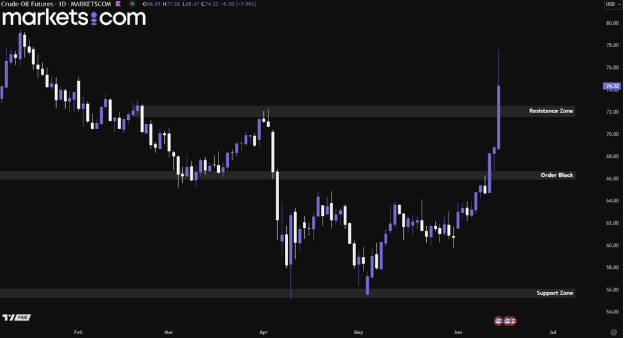CFDs are complex instruments and come with a high risk of losing money rapidly due to leverage. 77.3% of retail investor accounts lose money when trading CFDs with this provider. You should consider whether you understand how CFDs work and whether you can afford to take the high risk of losing your money.
Friday Jun 13 2025 07:23

5 min

Oil prices surged over 7% during Friday Asian session, reaching multi-month highs after Israel confirmed it had launched a strike on Iran. The escalation has sharply increased geopolitical tensions in the Middle East and raised concerns over potential disruptions to global oil supplies. Iranian media reported explosions in Tehran early Friday, following Israel’s strike, as U.S.-led diplomatic efforts to curb Iran's nuclear program faltered.
Israeli Prime Minister Benjamin Netanyahu stated the strikes were intended to damage Iran’s nuclear infrastructure, ballistic missile facilities, and other military capabilities. In response, Iran declared a state of emergency and signaled preparations for retaliation. This has amplified fears of broader instability across the region, especially among neighboring oil-producing nations, potentially triggering further contagion in global energy markets.

(Crude Oil Futures, Source: Trading View)
From a technical analysis perspective, crude oil futures have rebounded from the support zone of 55.20 – 56.20, showing strong bullish momentum accompanied by a double bottom candlestick pattern. Recently, the price broke above the order block at 66.00 – 66.60 and the resistance zone at 71.50 – 72.50 with significant upward momentum, signaling the reversal from a bearish to a bullish trend in the near term. This breakout could potentially drive the price even higher.
Japanese equities declined for a second straight session on Friday, with the Nikkei 225 falling 1.4% to below 37,700. The selloff was driven by heightened geopolitical tensions following Israel’s preemptive strike on Iran, which Prime Minister Benjamin Netanyahu said the strike targeted Tehran’s nuclear program. He also warned that Iran retains the ability to retaliate, fueling concerns of broader regional instability.
In addition to Middle East tensions, market sentiment was further weighed down by growing unease over U.S. trade policy. President Donald Trump reignited fears of a trade war by threatening to impose unilateral tariffs aimed at forcing new trade agreements with key partners. These combined risks have unsettled investors and triggered a risk-off mood in global markets.

(Nikkei 225 Index Daily Chart, Source: Trading View)
From a technical analysis perspective, the Nikkei 225 index has been in a bullish trend since April 2025, rebounding from the support zone of 31,700 – 32,200, as evidenced by the formation of higher highs and higher lows. However, the index was recently rejected from the order block at 38,400 – 38,700, which may potentially drive the index lower to retest the swap zone at 36,200 – 36,600.
On Thursday, AMD CEO Lisa Su unveiled a new AI server platform set for release in 2026, aiming to challenge Nvidia’s dominant position in the market. The announcement gained further traction after OpenAI’s CEO revealed that the ChatGPT creator plans to adopt AMD's latest chips. As the AI chip race intensifies, the focus has shifted from selling standalone processors to delivering entire server systems, integrated with dozens or even hundreds of chips and networking components from a single vendor.
Despite the high-profile launch, AMD shares fell 2.2% following the announcement, indicating the new chips are unlikely to immediately alter AMD's competitive standing. While AMD continues to trail Nvidia in the fast-expanding AI chip market, the company has been making significant strides by enhancing its software stack and developing high-performance chips to rival Nvidia’s offerings.

(AMD Daily Share Price Chart, Source: Trading View)
From a technical analysis perspective, AMD’s price has been in a bearish trend, as indicated by a series of lower highs and lower lows within a descending channel. However, since April 2025, the price has rebounded from the lower boundary of the channel and recently broke above the resistance zone of 113 – 116, signaling that bullish momentum has regained control. As a result, the persistent buying pressure may potentially push the price higher, with a retest of the upper boundary of the descending channel likely.
When considering shares, indices, forex (foreign exchange) and commodities for trading and price predictions, remember that trading CFDs involves a significant degree of risk and could result in capital loss.
Past performance is not indicative of any future results. This information is provided for informative purposes only and should not be construed to be investment advice.